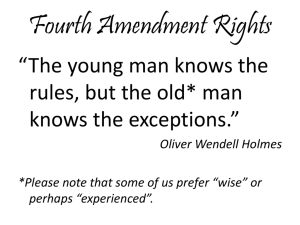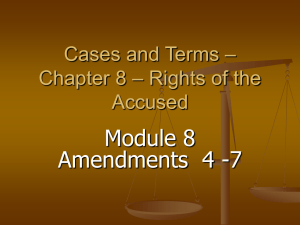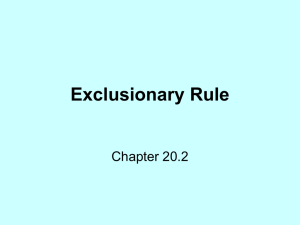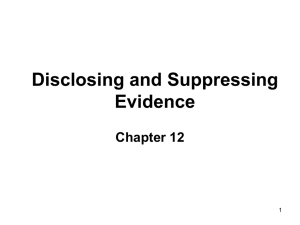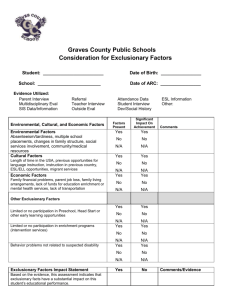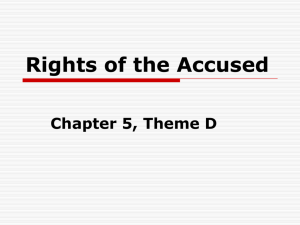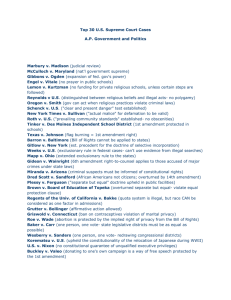+ 2 (,1 1/,1(
advertisement
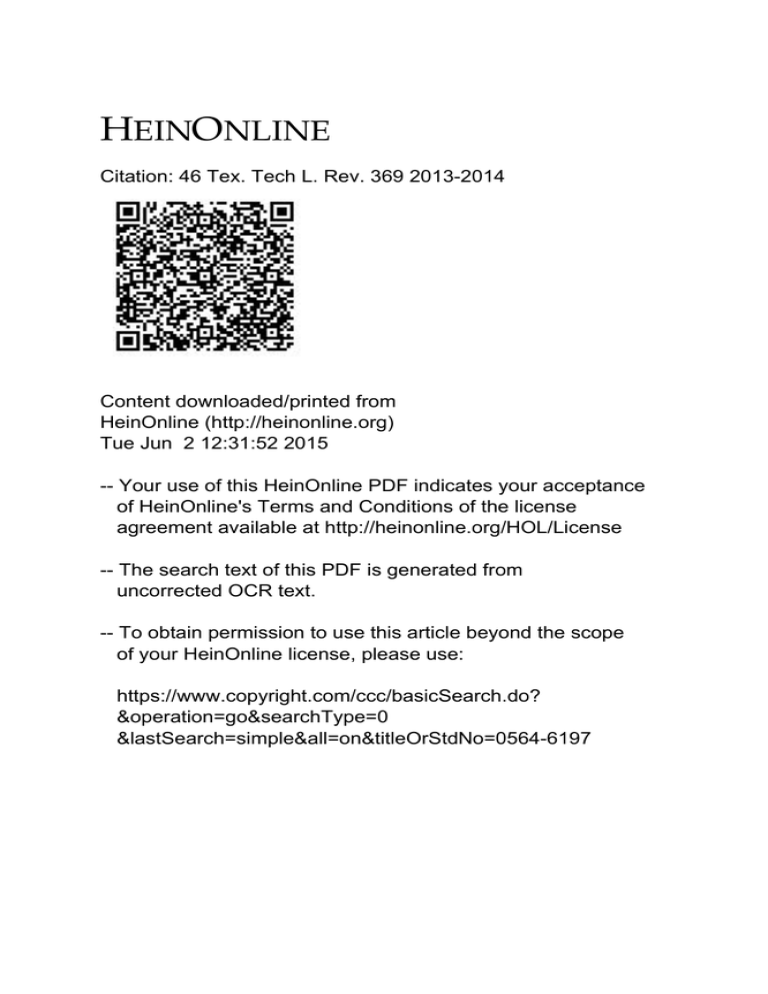
+(,121/,1( Citation: 46 Tex. Tech L. Rev. 369 2013-2014 Content downloaded/printed from HeinOnline (http://heinonline.org) Tue Jun 2 12:31:52 2015 -- Your use of this HeinOnline PDF indicates your acceptance of HeinOnline's Terms and Conditions of the license agreement available at http://heinonline.org/HOL/License -- The search text of this PDF is generated from uncorrected OCR text. -- To obtain permission to use this article beyond the scope of your HeinOnline license, please use: https://www.copyright.com/ccc/basicSearch.do? &operation=go&searchType=0 &lastSearch=simple&all=on&titleOrStdNo=0564-6197 THE EXCLUSIONARY RULE AS A REMEDY Arnold H. Loey I. WHY THE EXCLUSIONARY RULE Is NOT A RIGHT ..................... 369 II. How THE EXCLUSIONARY REMEDY SHOULD WORK ................ 370 III. CONCLUSION .............................................. 376 One of the great debates in exclusionary rule literature is whether the exclusionary rule of the Fourth Amendment ought to be viewed as a remedy for Fourth Amendment violations or whether the exclusionary rule is an inherent right. Although the Supreme Court once seemed to embrace the concept that the exclusionary rule was an inherent right of the victim of a Fourth Amendment violation,' it is now clear that the Court views the exclusionary rule as a remedy.2 Indeed, in some of the Court's more recent pronouncements, it is at least suggested that it is a remedy to be used sparingly. 3 In this Article, I shall argue that the Court was correct in concluding that the exclusionary rule is a remedy, rather than a right. I shall then argue that the Court has been incorrect in its parsimonious use of the exclusionary rule as a remedy in that the Court consistently undervalues the importance of the exclusionary rule and, at the same time, overrates the harm that the rule can do. I. WHY THE EXCLUSIONARY RULE Is NOT A RIGHT To say that the exclusionary rule is not a right seems counterintuitive. To illustrate, I think back to when I first learned about the exclusionary rule. I was 4 a junior in college, and Mapp v. Ohio had not yet been decided. I was a member of the debate team at Boston University, and my coach was a 3L member of the National Moot Court Team at Boston University School of Law.5 His moot court issue was whether Wolfv. Coloradoshould be overruled and replaced with the exclusionary rule. 6 * George R. Killam, Jr. Professor of Criminal Law, Texas Tech University School of Law. The author would like to thank Kathy Kassabian for her assistance in preparing this essay. This paper was presented at a Remedies workshop hosted by Professor Russell Weaver of the University of Louisville. 1. See Mapp v. Ohio, 367 U.S. 643, 650-51 (1961). 2. See United States v. Leon, 468 U.S. 897,908 (1984); United States v. Calandra, 414 U.S. 338, 354 (1974). 3. See, e.g., Hudson v. Michigan, 547 U.S. 586, 594 (2006) (holding that the exclusionary rule was inapplicable to the specific facts of the case). 4. Mapp, 367 U.S. at 643. 5. His name was John Burgess. Incidentally, one of his teammates was F. Lee Bailey. 6. Wolf v. Colorado, 338 U.S. 25 (1949), overruled by Mapp, 367 U.S. 643 (1961). 369 370 TEXAS TECH LAW RE VIEW [Vol. 46:369 I remember that when he explained Wolf to me, I was flabbergasted. I said: "Do you mean that under the current law, the State could unconstitutionally seize evidence from somebody and use it anyway?" He said "Yes." I replied: "That sounds crazy. I could understand deciding that something was not unconstitutionally seized, but I could not understand saying that (1) it was unconstitutionally seized, but (2) it is admissible anyway." So why was I wrong? I think that the answer is the nature of the right. The Fourth Amendment freedom from unreasonable searches and seizures is basically a substantive right. That is, it is designed to protect innocent people from being subject to search.7 It is not primarily concerned with trial fairness. Perhaps a good analogy would be to the Third Amendment, which also protects the substantive right of privacy.9 Surely nobody believes that if a soldier is quartered in a house in violation of the Third Amendment, he could not report evidence of crime that he discovered while so quartered. So, you might ask, if we would never exclude evidence obtained from a violation of the Third Amendment, why should we ever exclude evidence obtained from a violation of the Fourth Amendment? Put differently, why not just abolish the exclusionary rule? The answer is that governments do not quarter soldiers for the purpose of finding evidence. They do, however, search and seize for that purpose. Consequently, we do need an exclusionary rule to eliminate the incentive to violate the Fourth Amendment. II. How THE EXCLUSIONARY REMEDY SHOULD WORK In assessing how the remedy should work, it is important to evaluate why we have it. It is not to compensate innocent victims of the search and seizure, but to deter or, more accurately, to create a disincentive for police. Consequently, the wisdom of using the exclusionary rule should be assessed on a cost-benefit basis, and standing should be irrelevant. The Court does attempt to assess the value of the exclusionary rule on a cost-benefit basis, albeit, for reasons that will appear below, not very well. However, it insists on maintaining and, indeed, expanding the standing doctrine. In assessing the importance of the exclusionary rule, I would suppose the first principle is to assess the importance of the Fourth Amendment itself. If one were to think of the Fourth Amendment as a petty annoyance that interferes with valuable police work, then deterring violations would not seem like such a big deal. On the other hand, if we were to consider the Fourth Amendment an 7. See Arnold H. Loewy, The FourthAmendment as a Devicefor Protectingthe Innocent, 81 MICH. L. REv. 1229, 1264-66 (1983). 8. Cf United States v. Verdugo-Urquidez, 494 U.S. 259, 264-70 (1990) (explaining why the Fourth Amendment was not applicable to a search of a foreign national conducted in a foreign country). 9. U.S. Const. amend. I11 ("No Soldier shall, in time of peace be quartered in any house, without the consent of the Owner, nor in time of war, but in a manner to be prescribed by law."). 2014] THE EXCLUSIONARY RULE AS A REMEDY 371 important bulwark to protect the citizenry from being potentially victimized by a police state, then deterring police violations would seem very important. By any standard, the American view, at least insofar as we express it, is closer to the latter.'o We purport to take the Amendment seriously. Although I have certainly seen cases in which I do not think the Court has taken the Fourth Amendment seriously enough," the Court tends to return to serious Fourth Amendment jurisprudence when it can imagine itself or those it cares about as the potential victims of police excesses.12 The problem, of course, is that when the police are justified in conducting a search and seizure, that is what we want them to do. So, one could argue that strict application of the exclusionary rule might discourage the police from effectuating an arrest that we really wish they could effectuate. To a large extent, this fear informed the Court's decision in Hudson v. Michigan, where the Court refused to apply the exclusionary rule to a presumed failure to adhere to the knock-and-announce rule.' 3 Specifically, the Court feared that because of the vagueness of the knockand-announce rule (i.e. the rule would not even apply if the police had had reasonable suspicion that the searchee was either dangerous or likely to destroy evidence), the police could not have been sure whether they were required to knock and announce. 14 Consequently, the Court reasoned that application of the exclusionary rule might lead police to knock and announce when they do not need to, which could further lead to an unfortunate result: either harm to officers or destruction of evidence.' 5 Of course, harm to officers or destruction of evidence is never what anybody wants. However, the underlying rule takes care of that quite nicely. In the first place, there is not, and never was, an absolute knock-and-announce rule. In the first case holding that the knock-and-announce concept was part of the Fourth Amendment, Wilson v. Arkansas, the Court underscored that knockand-announce was a factor to consider in assessing reasonableness. 16 Failure to knock and announce was not per se unreasonable. Subsequent cases have held that even reasonable suspicion that the searchee is armed or that he might 10. See Brinegar v. United States, 338 U.S. 160, 180-81 (1949) (Jackson, J., dissenting). 11. See U.S. CONST. amend. IV; see, e.g., Hiibel v. Sixth Judicial Dist. Court of Nev., 542 U.S. 177, 188-89 (2004), discussed in Arnold H. Loewy, The Cowboy and the Cop: The Saga ofDudley Hiibel, 9/11, and the Vanishing FourthAmendment, 109 PENN. ST. L. REv. 929 (2005); Schneckloth v. Bustamonte, 412 U.S. 218, 248-49 (1973), discussedin Arnold H. Loewy, Knowing "Consent" Means "Knowing Consent": The UnderappreciatedWisdom ofJustice Marshall'sSchneckloth v. Bustamonte Dissent, 79 MIss. L.J. 97 (2009). 12. See United States v. Jones, 132 S. Ct. 945, 953-54 (2012); see generally Orin S. Kerr, An Equilibrium-Adjustment Theory of the Fourth Amendment, 125 HARv. L. REv. 476 (2011) (suggesting a theory to explain the complexities and alterations in Fourth Amendment jurisprudence). 13. Hudson v. Michigan, 547 U.S. 586, 594 (2006). 14. Id. at 594-95. 15. Id. 16. Wilson v. Arkansas, 514 U.S. 927, 936-37 (1995). 372 TEXAS TECH LAW REVIEW [Vol. 46:369 attempt to destroy evidence is enough to dispense with the knock and announce prior to entry.17 By that reasoning, Hudson was clearly not subjected to an unreasonable search. First, the police did knock before entering (albeit only three to five seconds before).18 Second, they had more than reasonable suspicion that he was armed because the warrant specifically authorized them to look for firearms and drugs.' 9 Consequently, had the question been litigated, the various courts that heard the case almost certainly would have found no violation of the knock-and-announce rule. 20 But for reasons not divulged by the record, the State of Michigan elected to concede that the knock-and-announce rule had been violated. 2' Yet, as Justice Breyer convincingly demonstrated in his dissent, if the prosecutor had only asked that the normal knock-and-announce rule be applied, the entry in Hudson would have been perfectly lawful. 2 2 So, what the Court was saying in Hudson is that the risk of a police error against the police's own interest-and in favor of the citizen's interest-is so substantial that we cannot risk it. Therefore, policemen need to know that if they think it is necessary to dispense with the knock-and-announce rule, they can do so without fear of losing the evidence if they are wrong. There are at least two things wrong with this analysis. In the first place, the case was either contrived or badly argued. Consequently, the Court could -and probably should-have dismissed certiorari as improvidently granted. Alternatively, it could have decided the case on a ground not argued, namely that there was no violation of the knock-and-announce rule, and consequently, Hudson's conviction should have been affirmed. Secondly, the principle of not penalizing the police for a mistake lest they err on the side of inaction is fundamentally flawed as a general proposition. Would we not apply the exclusionary rule when the police enter somebody's home in the mistaken belief that there is an emergency? The police could certainly contend: "We want to enter whenever there is an emergency, and if we fear excluding evidence that we find in case there is not an emergency, we might not enter at all." To be sure, in that case, the primary motive of the police may not be to gain evidence, but it is hard to believe that obtaining evidence is not always in the back of a police officer's mind. So, do equitable principles compel allowing in evidence obtained following an unlawful search, lest its exclusion deter the police from conducting lawful searches in the future? I think that the answer to that question has to be "no," unless we believe the value of obtaining evidence 17. 18. 19. 20. 21. 22. See, e.g., Richards v. Wisconsin, 520 U.S. 385, 387-88 (1997). Hudson, 547 U.S. at 588. Id. See id. at 588-89. Id. Id. at 624 (Breyer, J., dissenting). 2014] THE EXCLUSIONARY RULE AS A REMEDY 373 significantly exceeds the value of the Constitution. I do not think that we believe that. Of course, that is not the whole story of the Hudson case. Part of the Court's thinking was that "deterrence of knock-and-announce violations is not worth a lot." 2 3 Of course, if that statement were correct, it would explain the case. If the knock-and-announce rule, unlike the "do-not-enter-without-awarrant-unless-there-is-an-emergency rule," were an unimportant piece of constitutional fluff, then maybe we could say that while we usually take enforcement of the Fourth Amendment seriously, we can make an exception for the unimportant knock-and-announce principle. Before relegating the knock-and-announce rule to the scrap heap of unimportance, it is worth recalling that it comes with such an impressive pedigree that little more than a decade earlier a unanimous Court (and how many of those do we have in Fourth Amendment jurisprudence?) held that it was a part of the Fourth Amendment.2 4 Justice Scalia, who wrote the majority opinion in Hudson, was one of the signers of that unanimous opinion, written by Justice Thomas (who had also joined Scalia's Hudson opinion). Still, Scalia, writing for the Court in Hudson, was able to say that "ignoring knock-and-announce can realistically be expected to achieve absolutely nothing except the prevention of destruction of evidence and the avoidance of life-threatening resistance by occupants of the premises . .. 25 If that were accurate, one would have to wonder whatever possessed the framers to adopt such a stupid constitutional provision. But, of course, that statement is not even close to accurate. The Fourth Amendment is not designed to protect the armed drug dealers of the world. It is designed to protect the innocent. So, in measuring how to apply the exclusionary rule, we should think of the rule's impact on the innocent. Let us suppose that the police have probable cause to believe that Bradley Jones of 2222 22nd Street has filed false tax returns for the past five years. Suppose further that one police officer thinks he might be armed because, "You never can tell about the tax cheats." Suppose again that another officer says: "We have no reason to believe that he is armed, but hey, you never know. We do know if we kick down his door and find evidence of crime, the Supreme Court says it is admissible, so what do we have to lose?" Consequently, they kick down the door and Bradley, who, despite the warrant, was in fact innocent, dies of a heart attack from the shock. The Fourth Amendment is designed to protect people like Bradley Jones, not the Booker Hudsons of the world. Certainly that is true of the knock-andannounce rule. From that perspective, it is apparent that the Court grossly 23. Id. at 596 (majority opinion). 24. Wilson v. Arkansas, 514 U.S. 927, 937 (1995). 25. Hudson, 547 U.S. at 596. 374 TEXAS TECH LAW REVIEW [Vol. 46:369 undervalued the role that the exclusionary rule could play in protecting core Fourth Amendment values. Another place that the Court undervalues the work that the exclusionary rule could do is in its rather stringent standing requirements. Basically, the Court, bewailing the cost of the exclusionary rule, has refused to apply it unless the person against whom the evidence is sought to be introduced can establish that his personal rights were violated in obtaining the evidence. 26 I suggest that not only is this illogical if the rationale of the exclusionary rule is not to vindicate individual rights but to create a behavioral blueprint for the police, but also, it can create a positively perverse incentive. Consider this scenario: The police have reason to believe that George robbed a bank and has hidden the proceeds in either his apartment or his mother's home. They really do not know which. Under those circumstances, they probably cannot get a warrant to search either venue.27 So, what are the police to do? I suggest that they will search the mother's apartment first. If they find the proceeds there, George will not have standing to challenge the unlawful search.28 If they do not find the proceeds there and can rule out the mother's house as a possible locus of the proceeds, then they may be justified in getting a warrant to search George's apartment. Yet a rational jurisprudence would want to minimize the intrusion on George's innocent mother, rather than practically forcing it to be the first place to look. Lest anyone think that I am making this stuff up, consider United States v. Payner, where the IRS, desiring to trace Bahamian bank accounts, lured a Bahamian banker to the United States and set him up with a "special employee" on a dinner date. 29 While the banker and IRS employee were gone, the IRS agents entered the banker's hotel room, had a locksmith open his briefcase, removed and copied papers therefrom, and returned everything before the unsuspecting banker returned from dinner.30 The papers were then used to convict Americans of tax evasion.3 ' The IRS admitted that it deliberately manipulated the standing requirements so that it could unlawfully search the banker's hotel room and use the evidence against his clients.32 Nevertheless, the Court held that neither the Fourth Amendment exclusionary rule, nor the Court's supervisory powers justified excluding the evidence at the behest of one whose personal Fourth Amendment rights were 26. See, e.g., Rakas v. Minois, 439 U.S. 128, 139 (1978). 27. I suppose it is plausible that an expansive reading of the "fair probability" standard as first announced in Illinois v. Gates, and subsequently applied in Marylandv. PringleandFloridav. Harris,might allow a search of both places, but for the purpose of this analysis I assume that is not the case. See Florida v. Harris, 133 S. Ct. 1050, 1055-56 (2013); Maryland v. Pringle, 540 U.S. 366,370-71 (2003); Illinois v. Gates, 462 U.S. 213, 238 (1983). 28. See United States v. Salvucci, 448 U.S. 83, 85 (1980). 29. United States v. Payner, 447 U.S. 727, 729-30 (1980). 30. Id at 730. 31. Id. at 728. 32. Id. at 742-43. 2014] THE EXCLUSIONARY RULE ASA REMEDY 375 not violated. Surely one would have thought that equitable principles counseled in the other direction. To put it mildly, the government did not have "clean hands." Yet the Court refused to adopt what I would have called "the bad faith exception to the non-exclusionary rule." Not only has the Court undervalued the good the exclusionary rule can do, but it has also grossly overstated the harm done by the rule. Nowhere was that more apparent than in Herring v. United States.3 3 Herring involved a somewhat overly exuberant police officer named Mark Anderson. Anderson, upon hearing that Bennie Herring was retrieving an item from an impounded truck, asked his county's police clerk to check for outstanding warrants. 34 When she found none, Anderson asked her to check the records in the neighboring county, and sure enough, the clerk reported an outstanding felony warrant. Not wanting to lose this "aha moment," Anderson followed Herring out of the impound lot and arrested him. More prudently, the clerk asked her counterpart to fax the arrest warrant for their records and to confirm its accuracy.37 A few minutes later, the counterpart called back and said that there had been an error and, in fact, the warrant had been recalled five months earlier. By this time, Anderson had collared his quarry and determined that he possessed both methamphetamine and a gun (which, as a felon, was unlawful). 3 9 The Government sought to admit the evidence on the grounds that (1) the police clerk's error was merely negligent, and (2) nobody in the police department had acted recklessly or intentionally.4 0 The Court agreed. 4 1 Throughout its opinion, the Court consistently bewailed, as it had done in earlier cases, the high cost of the exclusionary rule.42 Indeed, it ended its opinion by paraphrasing Justice Cardozo and saying that where the error was merely negligent, "the criminal should not 'go free because the constable has blundered. ,,43 Well, that certainly seems fair enough and consistent with basic equitable principles, if it were true. But it was not true in this very case. If the exclusionary rule were applied, Benny Herring would not have gone free because Mark Anderson or the police clerk had blundered. Rather, he would have gone free because he would have gone free if they had not blundered. 33. See generally Herring v. United States, 555 U.S. 135 (2009) (asking whether contraband found during an unlawful arrest must be suppressed in a subsequent prosecution). 34. Id. at 137. 35. Id. 36. Id. 37. Id. 38. Id. at 138. 39. Id. at 137-38. 40. Id at 138-39. 41. Id. at 139. 42. See, e.g., United States v. Leon, 468 U.S. 897 (1984). 43. Herring,555 U.S. at 148 (quoting People v. Defore, 150 N.E. 585, 587-88 (N.Y. 1926)). 376 TEXAS TECH LAW REVIEW [Vol. 46:369 Let me explain. Suppose that Dale County, Alabama, had its computers running the way they were supposed to, and Benny Herring's recalled warrant had not been found therein. Under those circumstances, Herring would not have been arrested, and the evidence would not have been found. So, if the constable had not blundered, the criminal would not have been arrested and the evidence never would have been found against him. Consequently, he would not have been brought to trial. So, by applying the exclusionary rule, all the Court would have done is restore the status quo ante. That would have put Herring and the Government in exactly the positions that they would have been in had there not been a violation. This does not seem like an excessive cost to me. III. CONCLUSION So, my conclusions are that (1) the exclusionary rule is not an inherent right and should be, as it is, treated as a remedy; (2) in assessing the remedy, an appropriate balance is necessary; (3) a balance needs to weigh the factors accurately; (4) the Court has consistently understated the value that the exclusionary rule has in enforcing the Fourth Amendment; and (5) the Court has consistently overstated the harm that the exclusionary rule does to legitimate law enforcement interests. Therefore, it is my recommendation that the Court seriously reevaluate the exclusionary rule to reach an appropriate remedial balance between the importance of the Fourth Amendment and the legitimate needs of law enforcement.
